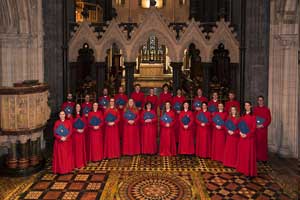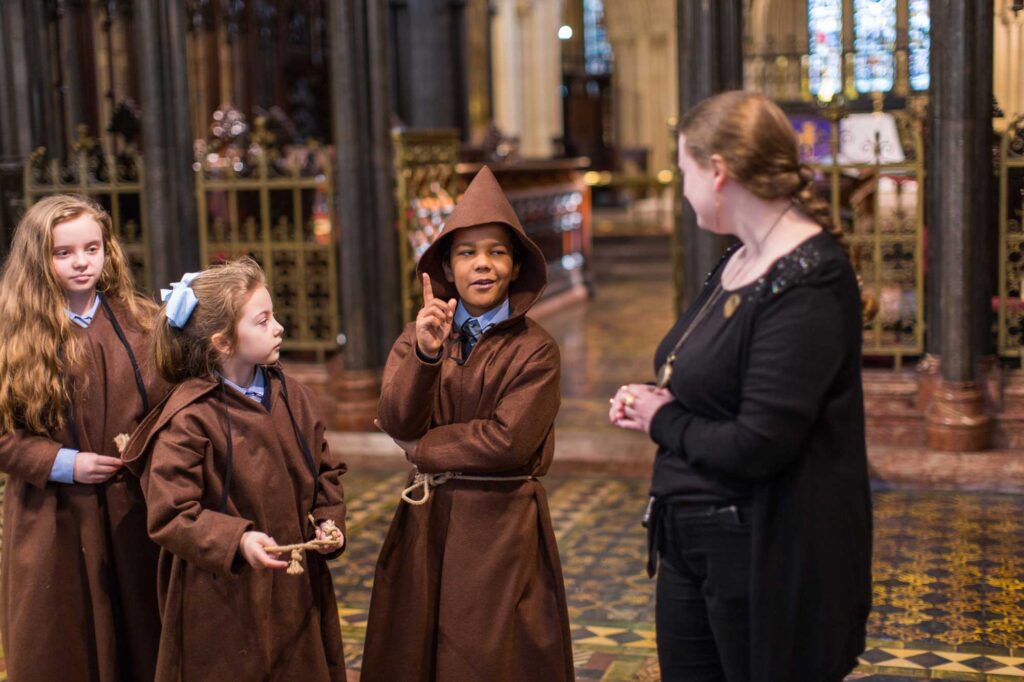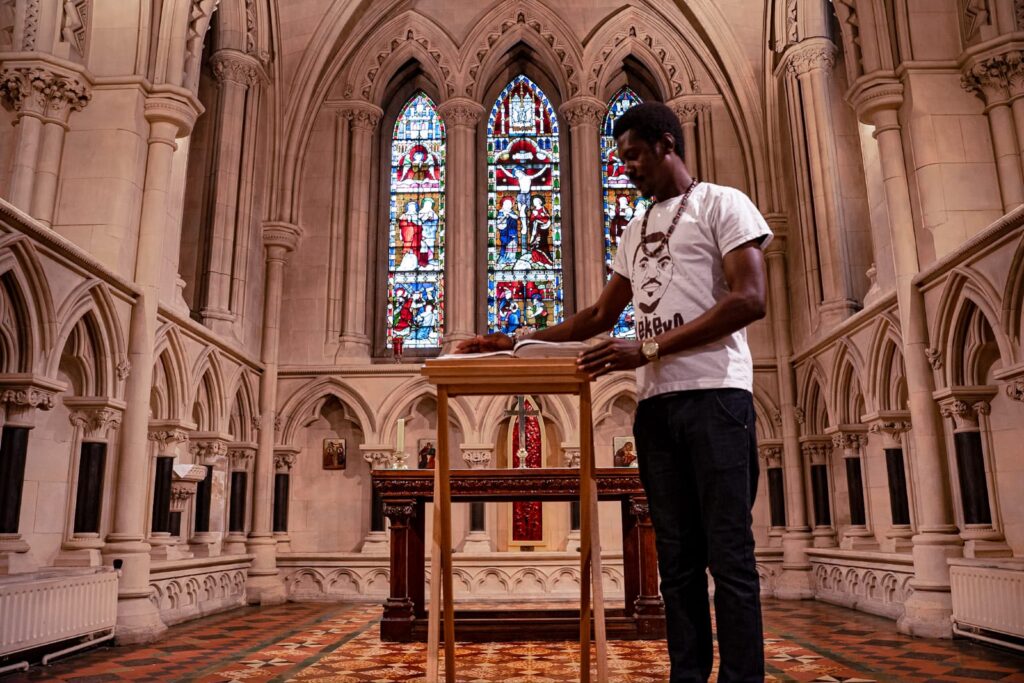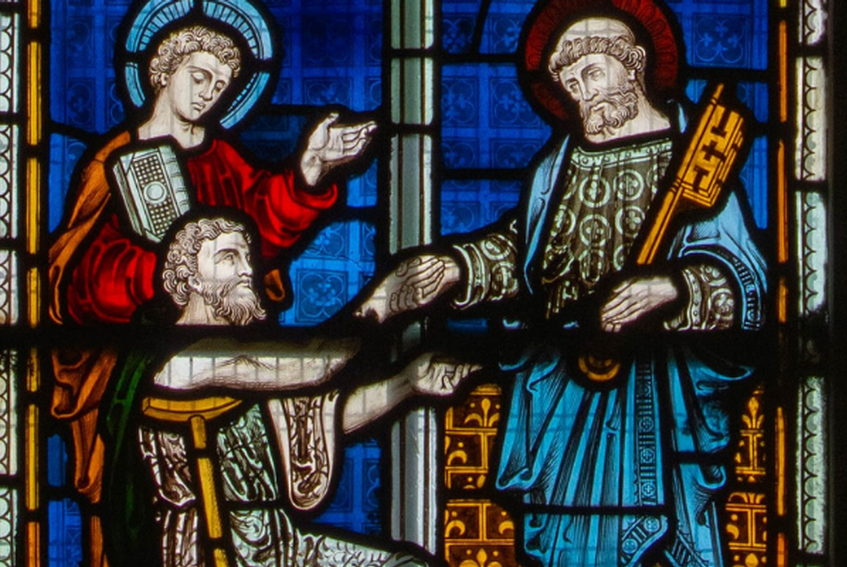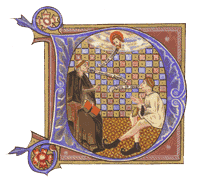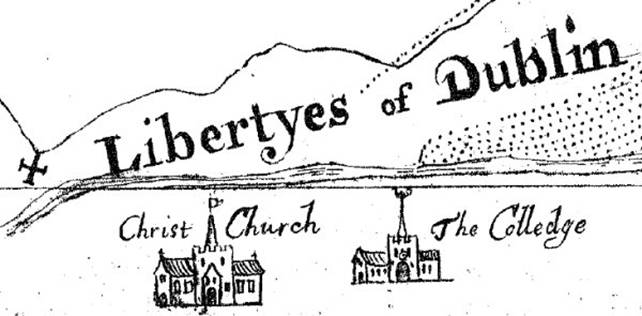Christ Church Archives and Publications
An Archival Tradition
The archive of Christ Church contains one of the longest continuous collections of records of any institution in Ireland. Shedding light on power and politics from archbishops to yeomen from Sitriuc to McAleese, it is widely used by historians of Dublin, the Pale and beyond; by ecclesiastical historians examining the medieval church, the Church of Ireland, and changes in ecclesiastical practice; by historical geographers examining Christ Church’s property as a cathedral priory and as landed estates of the Ascendancy’s ecclesiastical gentry; by architectural historians deconstructing buildings, their architects and craftsmen; and by musicians investigating former sonic worlds so intimately connected with the cathedral’s continuing tradition of worship evident in its sung services, the Sunday eucharist and the more frequent offices of choral evensong.
The archival record, by necessity, has been copied over the centuries to ensure its survival, such as the martyrology of saints most likely imported from Cologne at the foundation of the cathedral which survives in a fourteenth-century manuscript transcription, or the compilation of many of its most important records into a register in the late fifteenth and early sixteenth centuries by teams of Dublin notaries including Thomas Fich, sub-prior (1502-16). Many of the more important deeds were transcribed into three volumes known as the ‘Registrum Novum’ by a group of eighteenth-century clerical antiquarians including Swift’s emanuensis, John Lyon, a canon of St Patrick’s cathedral, and Christ Church chapter members: John Owen, prebend of St Michael’s; his successor, the Revd William Fletcher; and the precentor, Isaac Mann. This tradition continued into the nineteenth-century, when the entire cathedral deed collection was calendared and the greater part of it published by M.J. McEnery, a government archivist and a member of the cathedral congregation. This was a remarkably fortunate undertaking given the destruction of the originals which took place when the Public Record Office was destroyed in 1922.
Records
The earliest records of Hiberno-Norse property ownership were first written down in deeds formalised by the Anglo-Normans in the late twelfth century, listing such luminaries as kings of Leinster, the Hiberno-Norse MacTorcalls and later the Anglo-Normans themselves, and these deeds continued to record the transaction of the cathedral’s property until the end of the seventeenth century. Also surviving is a fourteenth-century account roll which gives an intimate impression of what life in the cathedral priory and its granges was like just before the ‘Black Death’ – incidentally, a children’s book, Where the Stones Sing by Eithne Massey, set at Christ Church at this time, has recently been published. Following the Reformation, the constitution of the cathedral was reformed as a ‘secular’ cathedral, that is non-monastic, governed by a dean and chapter which was staffed by the former Augustinian prior and canons. This new chapter kept records in a series of chapter act books which form another set of cathedral documents spanning an remarkable chronological range from the 1570s until the 1870s. Added to these, are a series of proctors’ accounts written primarily by the chapter themselves who took turns as the ‘proctor’ or accountant of the cathedral. One of the most detailed, that of the precentor, Peter Lewis, survives from 1574-5, and like its medieval account roll counterpart, yields a vivid impression of life rebuilding the cathedral after the fall of the south wall and roof in 1562. Other surviving records include manuscript music produced during one heyday of the cathedral’s musical life, the mid-eighteenth century when the legacy of the Roseingraves – both father and son had been organists – produced a lively and co-operative musical life between Christ Church and St Patrick’s, and regular engagement with the life of the city through oratorios and other musical performances. The archives also include maps of cathedral property, culminating in several early nineteenth-century collections which document the extent of Christ Church lands just before their confiscation under the Church Temporalities Act of 1833. Around the time of the disestablishment of the Church of Ireland in the 1870s, and possibly arising from the lay and clerical committee involved in overseeing Henry Roe’s restoration of the cathedral from 1871-8, a Board was founded which began to share with the chapter the management of the cathedral. Today that Board consists of clergy, some ex-officio, other elected by the chapter, together with members of the General Vestry who are elected triennially at an Easter Vestry. The minutes kept by that Board (and those of its committees) today continue a remarkable tradition of record-keeping inherited from the secular chapter and the Augustinian chapter before it, dating all the way back to the foundation of the cathedral.
Present
Today, Christ Church’s collections straddle two locations. At the cathedral itself, a reference library, an eighteenth-century printed music library and the collection of the former dean of Lismore, the Very Revd Gilbert Mayes, as well as more recent archives are maintained on-site in the crypt, and are accessible by arrangement. The more valuable manuscripts and older material is preserved in the Representative Church Body Library in Rathgar, which is the publicly accessible research library and archive of the Church of Ireland. At the RCB Library, the Librarian and Archivist is Dr Raymond Refaussé (a member of the cathedral Culture committee), while at Christ Church, the Honorary Keeper of the Archives is Dr Kenneth Milne, and the Research Advisor is Dr Stuart Kinsella.
Website Archive
In addition to physical archives, since 1996 the cathedral has had a website, and the first and second incarnations of these are still accessible online. The first website in particular is a useful resource chronicling events at the cathedral from 1996-2009. With potentially limitless storage, the Internet is a powerful source as an archive of material which can be additively accumulated, already sorted for later consultation. From the religious life of the cathedral, some of the materials available on the first website include copies of sermons (1999-2009), records of a discussion group (1998-2004), suggested intercessions (2001-9), Celtic services such as Spiorad, lists of preachers (2005-9), as well images of confirmations, ordinations, installations, consecrations and religious art. The administrative side of the cathedral is represented in the cathedral constitution, accounts of former Easter Vestries (1999, 2002), timelines of former clergy of the cathedral, lists of former vergers, sextons, beadles and so forth, as well as administrators, proctors, registrars and the like. Also preserved are details of former fundraising projects: Christ Church 2000, and of former conferences such as Ceiliúradh (2000, 2003), the Irish School of Ecumenics (2000), the Northern European Cathedrals (2001), the Pilgrims’ Association (2001), a Search colloquium (2004), and a Celtic Revival Summer School (2006). The Friends of the cathedral are also represented, listing their committee (1997-2006), duplicating where possible the Friends’ News online (2000-8), and listing their pilgrimages (1986-2007). The musicians are represented by lists of choir membership (1998-2009) as well as photographs of the choir going all the way back to c.1915. Also noted are new compositions written for the cathedral (1993-2007), choir-run concert series such as Cathedral Arts and the Christ Church Festival, as well details of the cathedral’s own orchestra, Christ Church Baroque (1996-2001), now the Irish Baroque Orchestra. Details of choir recordings (1986-2008), and reviews of concerts and CDs are also included, as well as lists of former organists, assistant organists, organ scholars, music librarians and school masters. For the belfry, regular ‘Ringers’ Intelligencer’ reports (2000-9) are preserved, as are lists of quarter (1981-2008) and full (1899-2008) peals, and recordings of the bells (2005-9). For the visitor, details of the Treasury in the crypt are included, as well as information about the cathedral and its surrounding area. From a heritage perspective, there are details of the cathedral’s education role which includes a series of 23 lunchtime lectures (1997-2007), the Joe Coady lectures (1987-2003), details of the Church of Ireland Historical Society which meets once a year at the cathedral (2007-9), and Heritage Week (2003-8). Of archival interest are lists of material available in the RCB library, as are genealogical guides for researchers, as well as some details of former keepers of the archives. Of longer duration, a list of publications on the cathedral are also include, comprising the cathedral history, the associated documents series, and its healthy academic spin-offs, such as a history of music at the cathedral, published lunchtime lectures, and booklets on the cathedral, the bells, tiles and stained glass, as well as over 50 reviews of many of these publications (1892-2007). Finally, the events, exhibitions, concerts and services of the cathedral can be traced in detail (showing just a few concerts and major services in 1996 compared to an substantial 27 in 2009), through the cathedral diary (1996-2009), the blog-like ‘What’s New’ (1996-2009), or indeed the main published public record of the cathedral’s activities from the Church Review (1996-2009). Finally, a partial list of the emails sent out on the cathedral email list (1997-2011), can be found on the justus.anglican.org servers (2004-11).
Stuart Kinsella, Feast of St Laurence O’Toole, 2011
For archival queries, please contact our Head of Education, Ruth Kenny at ei.hcruhctsirhc@ynnek.htur or our Research Advisor Stuart Kinsella at ei.hcruhctsirhc@sevihcra


